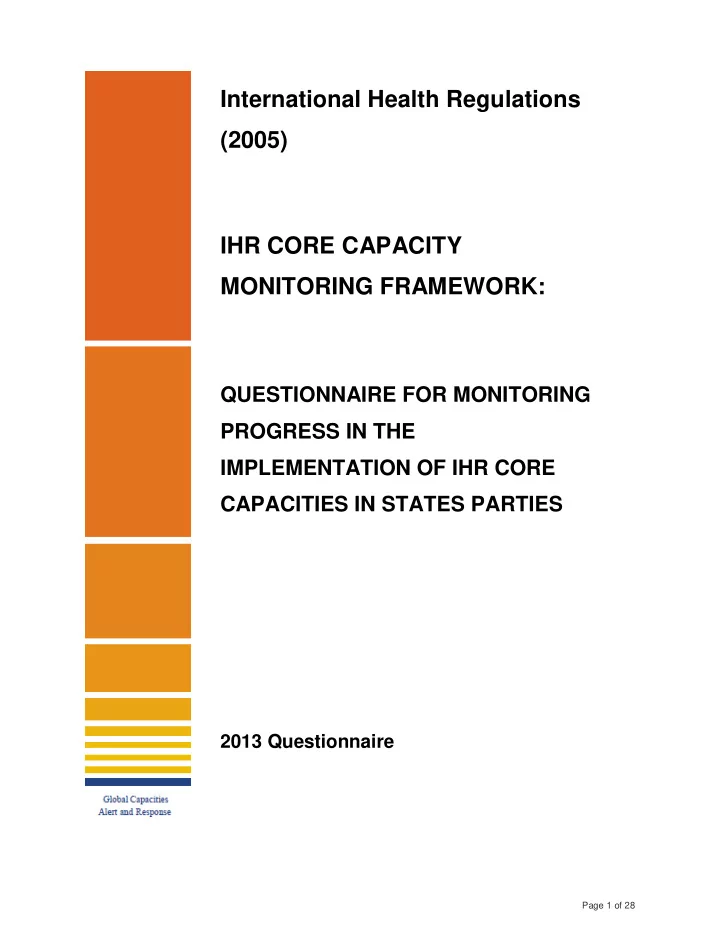

International Health Regulations (2005) IHR CORE CAPACITY MONITORING FRAMEWORK: QUESTIONNAIRE FOR MONITORING PROGRESS IN THE IMPLEMENTATION OF IHR CORE CAPACITIES IN STATES PARTIES 2013 Questionnaire Page 1 of 28
STATE PARTY MONITORING QUESTIONNAIRE FOR CORE CAPACITIES RELATING TO THE INTERNATIONAL HEALTH REGULATIONS (2005) - - - Date: / / (dd/mm/yyyy) The IHR Secretariat is required to provide an annual report to the World Health Assembly detailing WHO and States Parties progress on IHR implementation. In order to assist the States Parties in their responsibility to report to the Assembly, the IHR Secretariat has developed a data collection tool which will enable each State Party to provide standardized information about progress of its core capacity development in implementation of IHR (2005) (IHR). The completed data collection tool can be submitted to ihrmonitoring@who.int via email; or by fax to +41227911388 or +41227911399; or in hard copy to IHR Monitoring (HSE/GCR/MPI) 20, avenue Appia, 1211 Geneva 27 Switzerland. The submission of this questionnaire will allow the compilation of a consistent report to the Assembly. However, the use of this format by States Parties is entirely voluntary. All questions should be completed. Respondent identification State Party - - Name and title of contact officer for this report Telephone number - E-mail - Enquiries relating to the questionnaire should be directed to the IHR Monitoring Team at ihrmonitoring@who.int Please indicate top three priority areas for strengthening; For States Parties that have obtained a two- year extension, please also report progress against the implementation of IHR action plans submitted in the extension request and highlight areas where gaps still exist . - Page 2 of 28
INSTRUCTIONS FOR COMPLETING QUESTIONNAIRE This data collection tool is designed primarily for use by National IHR Focal Points (NFPs) in collaboration with public health professionals, managers and other sectors and stakeholders responsible for implementing the IHR. Completion of the questionnaire may require input from professionals and representatives from other sectors such as animal health, food and water safety, environmental health, radiological, nuclear, and chemical disciplines. Data collection should be carried out by the IHR NFPs in consultation with these experts. The data collection process can be accomplished through a workshop, with the questionnaires distributed to the relevant expert groups beforehand, or through other means as appropriate in a specific country context. WHO can provide technical assistance upon request by the States Parties. The completed data collection tool should be properly attested by the IHR NFP and submitted to ihrmonitoring@who.int, with copies to the WHO Regional Office and where available, to the WHO Country Office. The questionnaire is divided into thirteen sections, one for each of the eight core capacities, PoE and four hazards. Individual questions are grouped by Components and Indicators in the questionnaires. The individual questions are self-explanatory and any additional comments or contributions you may wish to make can be accommodated at the end of each section, in the comment box. Additional pages may also be added if required. For each question, mark only one appropriate value (Yes, No, or Not Known) or the appropriate percentages. For statistical purposes, the "Not Known" value will be computed as a "No" value. If a question is not applicable for your country context (in the Points of Entry section), please indicate this in the comment box provided at the end of each section along with the reason why it is not applicable. Please note that the "double questions" (marked as "a" and "b" respectively) in this questionnaire are sub-questions that are linked with each other. However, answering "No" to the first question will not make the second question "not applicable", i.e. "n/a" is not included in the possible responses to the second question in this case. Questions may cover multiple aspects of implementation, and it is important to note that when answering yes to a question, it should mean a yes to all such aspects. In order to answer " yes" to a given question both the presence (i.e. function is available) and quality of the function (i.e. the content is directly relevant to the indicator, component and the IHR) should be considered, and both must be present to qualify for a yes answer. Partly fulfilled functions can be further commented in the comments box, but should be answered as "no". "No" to a question therefore means all or part of the function is not present. If possible, please provide a link to, or a hard copy of: documentation of laws, policies, designated PoE and their competent authorities, authorized ports (with ISO, LOCODE, SSCC, SSCEC and Extension), website, publications, reports etc. Where the term "documented" or "documentation" is mentioned, this means a document or other evidence is available with the IHR NFP or relevant government authorities showing that the required function is achieved and the quality of that achievement is appropriate for that indicator. There is no need to submit relevant documentation or other means of evidence to WHO unless the country wishes to do so; Where the term "published" is mentioned, please refer to the relevant footnote for interpretation of the meaning if needed; Where the term "National" is used, for countries that have a federal system, this should be interpreted as being for the level appropriate for that function, as determined by the country . Page 3 of 28
Recommend
More recommend